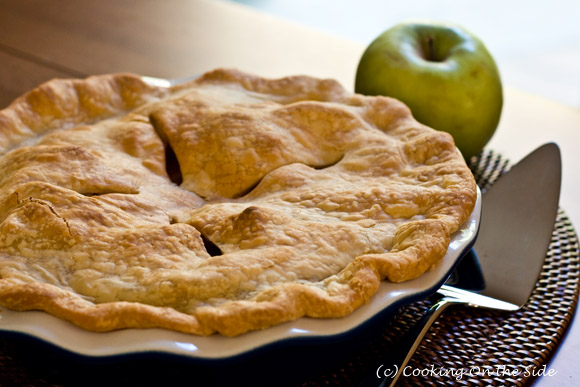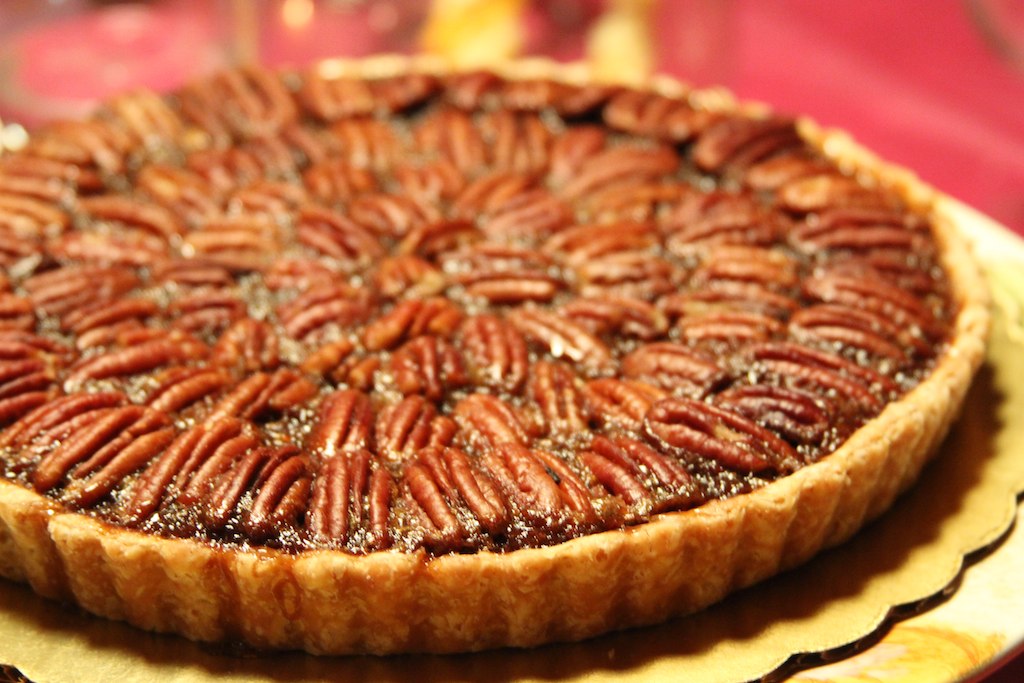
Ladies and gentlemen, I present that marvel of ingenuity, the all American hero, the…pie. You are nuts, you say. Well said, for one of the many brilliant designs of the pie is pecan. Seriously though, the pie plays an important role in our nation. This wonderful confection can serve as an allegory of our culture.
Like our country, the pie has a multitude of flavors. From symbolic apple to savory pork and decadent maple to delicate meringue, the rainbow of flavors spreads across a wide spectrum.
The ethnicity spectrum of the pie is just as wide as its flavors. Every culture that comes to our shores has its own versions of the pie.
Our culture has many ingredients combined within the uniting crust of Americanism to form an effective whole. To survive, the ingredients of both pie and America must work together. Who ever heard of a pie that was a household name, which was not delicious? The people of America must also work together if the country is to survive.
 |
| Apple Pie from cookingontheside.com |
Now, before we go any further, we may want to define pie. Originally, pie crusts were something called a ‘cofyn’, which was a long narrow crust.
Pies are now pastries that are usually baked in a round pan. This includes a crust placed in the bottom of the pan and often after the pie is filled, a second crust is added to the top. Most pies are baked, but there are a few modern pies, such as ice cream pie, that were born with the advent of the refrigerator.
There are berry pies and custard pies, apple pies with and without cheese, pumpkin custard and pecan
custard and sometimes a mix of the two. There are meat pies and pizza pies. Anything that can be put in a crust becomes a pie.
Pie is a symbol of the American home and a major part of early Americana. It migrated with the early settlers. Not only were they appreciated for their goodness, pies take only a small amount of flour, a valuable resource.
In America pie experienced a decline in the 1870s, because new nutrition experts decided that the dough in pies was weighing down the American spirit. The new jobs available to women cut down on the time in the kitchen and made pie making occasional rather than weekly.
Despite the decline pie remained a fixture on farms and a symbol of the American home. It was not nationally revived for eating until the 1980s in the rediscovering of American cooking.
 |
| Key Lime Pie |
In the beginning… Pumpkin pie. Fresh from the oven, spiced creamy golden-orange custard poured into a single piecrust, served with ice cream or whipped cream. This beloved pie has become a traditional part of American holiday celebrations such as Thanksgiving and Christmas.
Pumpkin pie started in an interesting way. The early settlers cut off the top of a pumpkin and scooped the seeds out. They would then fill the shell with sugar, spices and milk. The whole pumpkin would be baked in the fire. Early colonists actually used pumpkin flesh for piecrust instead of using it for pie filling.
In the words of John Greenleaf Whittier from his poem “Pumpkin”:
From North and from South comes the pilgrim and guest;
When the gray-haired New Englander sees round his board
The old broken links of affection restored;
When the care-wearied man seeks his mother once more,
And the worn matron smiles where the girl smiled before;
What moistens the lip and what brightens the eye,
What calls back the past, like the rich Pumpkin pie?
 |
| Pumpkin Pie from skinnytaste.com |
Apple pie is a two-crust pie containing cinnamon and nutmeg spiced apples. In America, apple pie became a synonym for being American. As the phrase ‘American as apple pie’ shows, apple pie is a symbol of America.
The Apple tree is worthy of the pie. The beauty of the pie is matched by the beauty of the tree all year round. In the spring the tree explodes into a ball of beautiful blossoms. During the summer, the leaves are a lovely dark green. With the fall comes the delicious fruit. In the winter, striped its leaves, the graceful branches can be seen.
Although apple pie is considered a truly all American dish, it was actually adopted. Apple trees came from Asia Minor and immigrated to our shores via England. They then migrated farther and farther west with the help of Johnny Appleseed, a popular American myth known for giving apple trees to people.
Eugene Field expressed his appreciation of apple pie in his poem, “Apple Pie and Cheese”:
…No flippant, sugared notion
Shall my appetite appease,
Or bate my soul’s devotion
To apple-pie and cheese!...
…No matter what conditions
Dyspeptic come to feaze,
The best of all physicians
Is apple-pie and cheese!...
…But I, when I undress me
Each night, upon my knees
Will ask the Lord to bless me
With apple-pie and cheese!
 |
| Pecan Pie from Wikimedia Commons |
Pecan pie, in the form that we know today, emerged with the popularization of Karo Corn Syrup. Pecans in transparent custard with a high sugar content baked in a single piecrust.
The pecan pie has its roots deep in the American South. According to tradition the pie itself is a concoction from the French colony at New Orleans. I’ve wondered if there was a relationship to praline.
The pecan tree is related to the hickory tree family and is native to the Mississippi valley. It is one of the few important plants native to the United States.
Shoo-fly pie, sticky, gooey cake pie, straight from the Pennsylvania Dutch. A cake made in a piecrust, the bottom soaking with molasses and the top sprinkled with a crumb topping. There are two variations: dry bottom, suitable for coffee dunking and wet bottom, with extra molasses.
No one really knows from where Shoo-fly pie or the strange name actually comes. It resembles an old English dish known as treacle tart, but has been claimed by many nationalities. Shoofly pie is now undeniably American.
Not only is custard pie delicious, it has a great deal to do with slapstick comedy. It seems that a lot of slapstick is not complete without someone getting a pie in his face. One short movie,
Battle of the Century, used three thousand pies in filming. Other kinds of pies have been used for this purpose, but custard pie seems to be favored, probably because it is now common to use only meringue, which is softer to receive in the face.
Not all pies are sweet. Some, such as the pizza pie, a flat bread crust with various toppings are meant for a main dish instead of dessert. Pizza is a very good example of a pie that has been made American.
Pizza, which immigrated to the United States from Italy, has become one of the most popular dinners in America. Pizzerias seem to be in every town in America and more than one of America’s major fast food chains specialize in serving pizza.
The roots of our country are in the world. We took ideas and principles from every culture and made them uniquely ours. In the same vein, American pie has its ancestors in every corner of the world.
In the end, everybody wants a slice of…the pie.
~ Rose
PS: Since today is Pi Day, I thought I'd do something appropriate to the occasion. ;)







